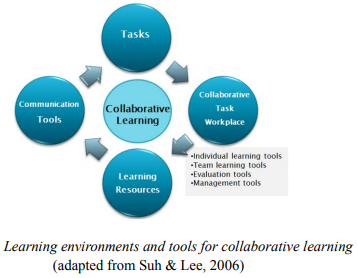e-Learning Ecologies MOOC’s Updates
Collaborative Intelligence – Peer to Peer Learning
Collaborative Intelligence – Peer to Peer Learning
Collaborative Intelligence or learning is a concept where two or more learners join together to learn a course in a digital space, for example, Coursera. Unlike Individual Intelligence/learning, two or more learners engaged in collaborative learning gain more benefits on knowing each other’s resources and skills such as information learned from each other, assessing each other’s knowledge/ideas and to monitor other learners work in a peer to the peer learning environment or in a larger group of learners. The ingredients of successful collaborative learning are the active interaction of group members, positive interdependency, and a strong sense of individual responsibility (Johnson & Johnson, 1986).
Collaborative learning environments and supported tools are composed of tasks, communication tools, collaborative task workplace, and learning resources (Suh & Lee, 2006).
Collaborative Intelligence leads to an effective social interaction among the learners and it is observed that it can be applied to a wide range of contexts with learners of different ages and learning backgrounds.
What is peer-to-peer learning and why is it important?
In an educational setting, peer-to-peer learning is the learning environment in which students teaching other students based on a particular concept or a task. On the other hand, Peer-to-peer learning in the workplace is similar albeit employees teaching one another. According to Dr. William Cope, a peer-to-peer learning environment is highly collaborative, constructive relationships with other team members or peers with a constructive peer feedback mechanism foster an effective learning environment. It also leads to a win-win situation for all learners. It can be described as a way of moving beyond independent to interdependent or mutual learning (Boud, 1988)
Although Peer learning is not a single, undifferentiated educational strategy, it encompasses a broad sweep of activities. For example, researchers from the University of Ulster identified ten different models of peer learning (Griffiths, Houston & Lazenbatt 1995). These models ranged from the traditional proctor model, in which senior students tutor junior students, to the more innovative learning cells, in which students in the same year form partnerships to assist each other with both course content and personal concerns.
Video Link: https://www.edutopia.org/video/3-ways-maximize-peer-peer-learning
According to continu – a blog, peer-to-peer learning is a cost-effective method of training and development. In 2010, Learning Solutions magazine reported that British Telecom was saving $12,000,000 per year by using an open-source learning solution and encouraging peer teaching in their organization (Eric. D, 2010).
Research conducted from the first year till the third year of engineering programs by three researchers on students' perceptions of the advantages of peer-to-peer learning in design/project-based learning, which includes real-world experience, teamwork, and interaction. The facts indicate that the present curriculum needs a change in teaching by implementing design/project-based units. About 34% of students state that they acquired interactive knowledge through teamwork, 15% of students mentioned that it develops collaborative skills, management skills, and social skills. It’s interesting to see 11% of the students indicate that they get the opportunity of managing large projects through real-world problems with industrial experiences (Jaideep.C, Sivachandran .C, Alex .C, 2014).
Peer-to-Peer learning encourages students to interact with each other to attain educational goals. Peer-to-Peer learning is essentially a self-directed and student-centered learning process that promotes lifelong learning. The continuous interaction among the peers promotes learning and this is being facilitated by the teachers through the use of technology resources is an effective approach in the learning journey.
(Images sourced from: https://medium.com/@NextPlane/why-the-future-of-work-lies-in-collaborative-intelligence-cfcdb8086bea, https://www.adp.com/spark/articles/2019/03/peer-to-peer-learning-can-help-employees-find-value.aspx# )
References:
Soller A., Goodman B., Linton F., Gaimari R. (1998) Promoting Effective Peer Interaction in an Intelligent Collaborative Learning System. In: Goettl B.P., Halff H.M., Redfield C.L., Shute V.J. (eds) Intelligent Tutoring Systems. ITS 1998. Lecture Notes in Computer Science, vol 1452. Springer, Berlin, Heidelberg
Teaching.cornell.edu (2020). Collaborative Learning | Center For Teaching Innovation. [Online] Available at: <https://teaching.cornell.edu/teaching-resources/engaging-students/collaborative-learning> [Accessed 10 May 2020].Johnson, D., & Johnson, R. (1986). Computer-assisted cooperative learning, Educational Technology, 25(1), 12-18.
Suh, H., & Lee, S. (2006). Collaborative learning agents for promoting group interaction. ETRI Journal, 28 (4), 461-474.
Continu Blog. 2020. What Is Peer-To-Peer Learning? | Continu Blog. [Online] Available at: <https://blog.continu.co/peer-to-peer-learning/> [Accessed 10 May 2020].
Learning Solutions Magazine (2020). Creating Safer Peer-To-Peer Learning Experiences. [Online] Available at: <https://learningsolutionsmag.com/articles/475/creating-safer-peer-to-peer-learning-experiences> [Accessed 10 May 2020].
Coursera (2020). Collaborative Intelligence, Part 5A: Social Learning - Module 3: Recursive Feedback + Collaborative Intelligence | Coursera. [Online] Available at: <https://www.coursera.org/learn/elearning/lecture/CoWOQ/collaborative-intelligence-part-5a-social-learning> [Accessed 10 May 2020].
Boud, D. & Walker, D. (1998). Promoting reflection in professional courses: the challenge of context. Studies in Higher Education, 23, 2, 191-206.
Chandran, Jaideep & Chandrasekaran, Siva & Stojcevski, Alex. (2014). Blended Approach for Peer-to-Peer Learning in Engineering Education. 2014 International Conference on Web and Open Access to Learning, ICWOAL 2014. 10.1109/ICWOAL.2014.7009193.



